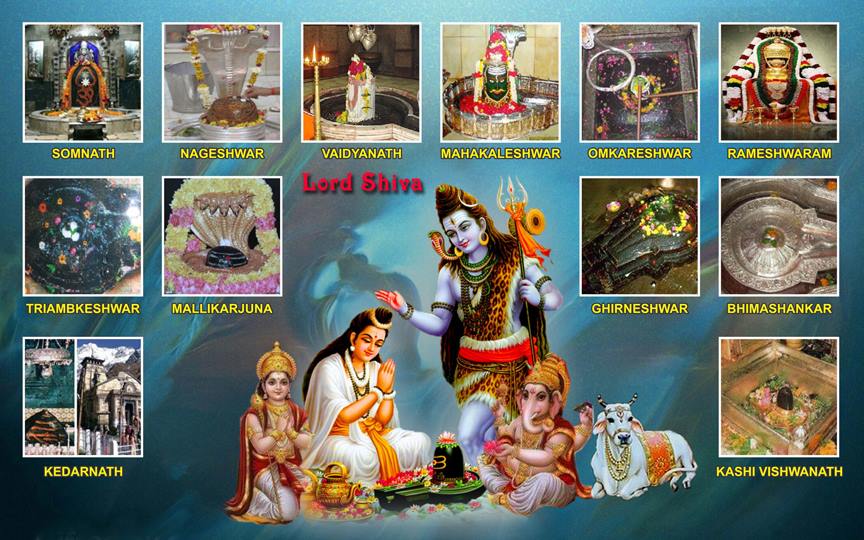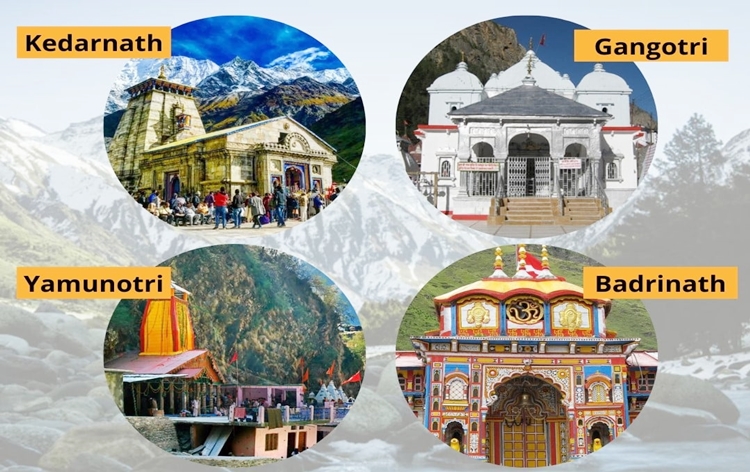
India, a land steeped in rich history and vibrant culture, is also a spiritual haven for millions. Among Hindus, two significant pilgrimages stand out: the 12 Jyotirlingas and 4 Dhams. These journeys hold immense spiritual significance, offering devotees a chance to connect with their faith, explore ancient traditions, and embark on a path of self-discovery.
The 12 Jyotirlingas: Abodes of Lord Shiva
Meaning and Significance: Jyotirlingas literally translate to “lingas of light,” representing the 12 most sacred abodes of Lord Shiva. Each Jyotirlinga enshrines a unique manifestation of the deity, signifying his diverse aspects and powers. Visiting all 12 Jyotirlingas in a lifetime is considered a remarkable feat by devout Hindus.
A Glimpse into 12 Jyotirlingas:
1. Somnath (Gujarat): Somnath, located in Prabhas Patan near Veraval in Saurashtra, Gujarat, is regarded as the first among the 12 Jyotirlingas. The temple has a rich history, having been rebuilt multiple times after facing destruction by foreign invasions. The serene surroundings and the rhythmic sound of the waves create an atmosphere conducive to spiritual introspection.
2. Mallikarjuna (Andhra Pradesh): Situated on the Srisailam mountain in Andhra Pradesh, the Mallikarjuna Jyotirlinga is associated with the sacred Patala Ganga. The shrine stands as a symbol of the cosmic unity of Lord Shiva and his consort, Goddess Parvati.
3. Mahakaleshwar (Madhya Pradesh): Nestled in the city of Ujjain, on the banks of the Shipra River, Mahakaleshwar is a powerful Jyotirlinga. The temple’s unique feature is the idol of Lord Shiva that faces south, unlike other Shiva temples.
4. Omkareshwar (Madhya Pradesh): Situated on the Mandhata Island in the Narmada River, Omkareshwar Jyotirlinga represents the sound ‘Om,’ which is considered the primordial vibration of the universe. The island’s natural beauty enhances the spiritual experience for pilgrims.
5. Kedarnath (Uttarakhand): Located in the Himalayas near the Mandakini River, Kedarnath is a remote yet spiritually charged pilgrimage site. Devotees embark on a challenging journey to seek the blessings of Lord Shiva in this pristine environment.
6. Bhimashankar (Maharashtra): Tucked away in the Sahyadri Range near Pune, Bhimashankar Jyotirlinga is associated with the legend of Lord Shiva’s battle against the demon Tripurasura. The temple’s unique architectural style adds to its allure.
7. Kashi Vishwanath (Uttar Pradesh): Situated in the ancient city of Varanasi, Kashi Vishwanath Jyotirlinga is one of the most revered temples in Hinduism. The spiritual aura of Varanasi and the Ganga ghats enhance the significance of this sacred site.
8. Trimbakeshwar (Maharashtra): Trimbakeshwar, located near Nashik, is known not only as a Jyotirlinga but also as the source of the sacred Godavari River. The temple’s distinctive feature is the three-faced linga representing Lord Brahma, Lord Vishnu, and Lord Shiva.
9. Vaidyanath (Jharkhand): Also known as Vaijnath, the Vaidyanath Jyotirlinga in Deoghar is associated with the mythological tale of Lord Shiva healing Ravana. The temple witnesses a massive influx of devotees during the holy month of Shravan.
10. Nageshwar (Gujarat): Situated on the Dwarka coast, the Nageshwar Jyotirlinga is unique for being guarded by a massive banyan tree. The temple has significant religious importance and is a serene place for spiritual contemplation.
11. Rameshwar (Tamil Nadu): Located on the island of Rameswaram, the Rameshwar Jyotirlinga is associated with the epic Ramayana and Lord Rama’s devotion to Lord Shiva. The temple is known for its long corridors and majestic architecture.
12. Grishneshwar (Maharashtra): The Grishneshwar Jyotirlinga, near the Ellora Caves, holds historical and spiritual significance. Devotees believe that a visit to this temple grants them relief from sins and brings divine blessings.

The 4 Dhams: A Pilgrimage Through the Four Cardinal Directions
Meaning and Significance: The four Dhams, meaning “abodes,” are pilgrimage sites scattered across India, associated with the four cardinal directions and representing a sacred Hindu circuit. Each Dham is dedicated to a specific deity and is believed to hold immense spiritual significance.
Exploring the 4 Dhams
- Yamunotri Dham (Uttarakhand): Dedicated to Goddess Yamuna, this dham marks the source of the life-giving river Yamuna, offering a chance to witness the majesty of nature and seek blessings from the divine feminine.
- Gangotri Dham (Uttarakhand): Nestled in the Garhwal Himalayas, this dham is revered as the source of the holy Ganges, the most sacred river in Hinduism. Pilgrims undertake the challenging journey to experience the serenity of the Himalayas and pay homage to the mighty river.
- Badrinath Dham (Uttarakhand): Ensconced in the scenic beauty of the Himalayas, this dham is dedicated to Lord Vishnu in his form of Badrinath. The scenic drive and the spiritual aura of the dham make it a truly unforgettable experience.
- Kedarnath (Uttarakhand): Perched amidst the majestic Garhwal Himalayas, Kedarnath is dedicated to Lord Shiva. The temple, situated near the Mandakini River, is one of the 12 Jyotirlingas and holds immense significance in Hindu mythology. The challenging trek to Kedarnath, often covered in snow, is seen as a test of one’s devotion and determination.
Planning Your Pilgrimage
- Time of Year: Weather conditions in certain regions can be harsh during specific seasons. Choose the time that best suits your physical capabilities and preferences.
- Physical Fitness: Some Jyotirlingas and Dhams involve trekking and navigating challenging terrains. Assess your physical fitness level and plan accordingly.
- Logistics: Research accommodation options, transportation facilities, and cultural sensitivities to ensure a smooth and enriching experience.
Beyond the Destination: The Inner Journey
While visiting these sacred sites is a central aspect of the pilgrimage, the true essence lies in the internal transformation it evokes. This journey offers a unique opportunity to:
- Deepen your connection with your faith and explore your spirituality.
- Immerse yourself in ancient traditions and witness age-old rituals firsthand.
- Appreciate the diverse cultural tapestry of India and encounter its vibrant spiritual essence.
- Embark on a path of self-discovery and inner peace.


